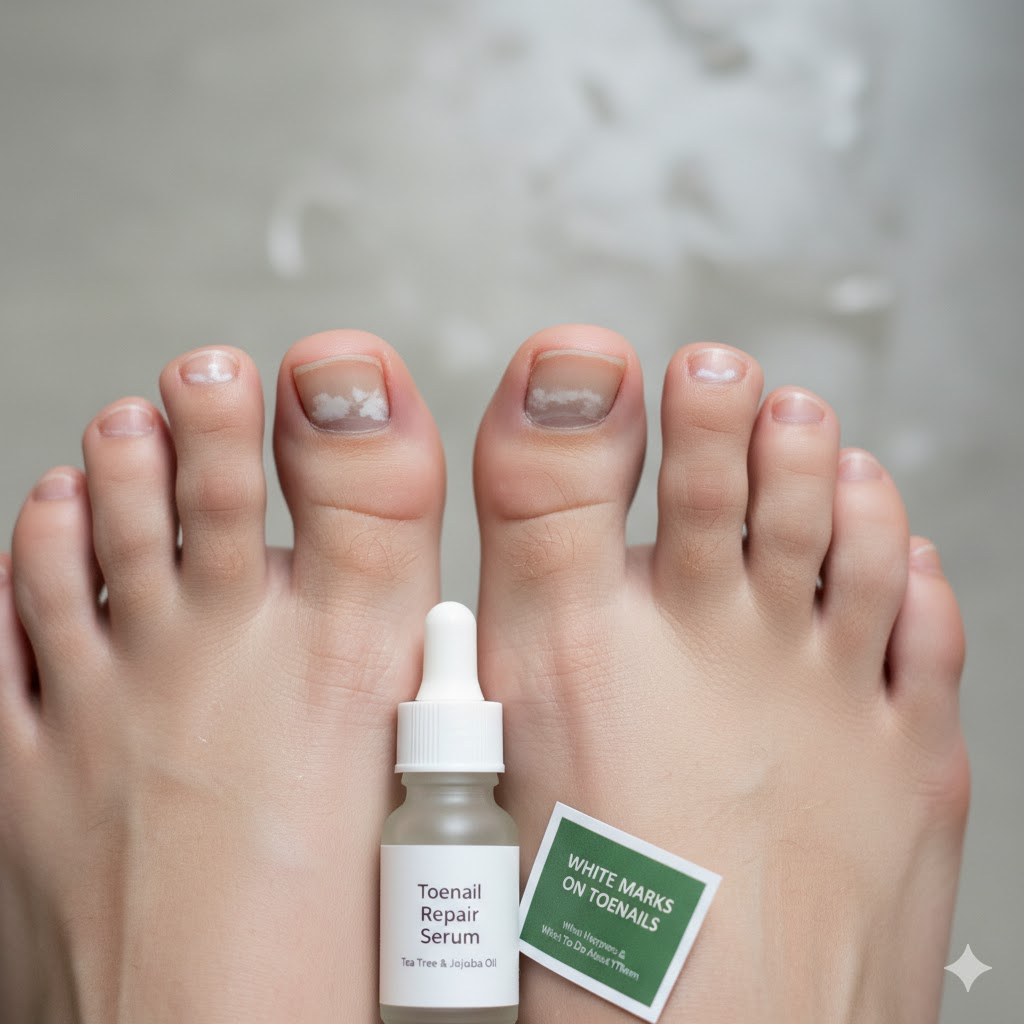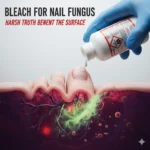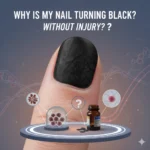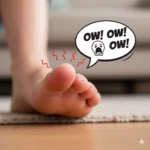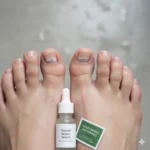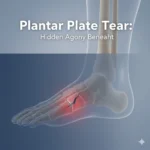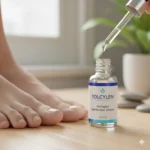White Marks on Toenails barefoot. out of the shower. You glance down and—wait, what’s that? A white dot on your toenail. Small. Harmless-looking. But your mind goes there. Is it fungus? Deficiency? Something serious?
That tiny spot, almost invisible last week, now feels like a clue. A whisper from your body. And here’s the thing your nails talk. Slowl, quiet, but they do. They record what your body’s been through. Every little bump brush of pressure off day of nutrition or stress.
Sometimes it’s nothing. Sometimes it’s not. Let’s talk about the white spots on your toenails! We will learn what they are. We will also learn when you need to worry and when you don’t.
Hidden Message Beneath White Marks on Toenails
Nails are like slow diaries. They don’t heal fast. They grow at their own pace—steady, patient, deliberate. A mark you see today might’ve started weeks ago. even months.
A stubbed toe in the dark. Tight shoes that pressed too hard. A long hike downhill. All tiny traumas. Each one capable of leaving a little mark that stays far longer than the pain.
But not all white spots are born equal. Some are cosmetic. Some are fungal. And a few—rare, but real—point to something deeper happening in your body.
If you’ve ever stared at your toenails and wondered what story they’re telling, this is your guide.
White Marks on Toenails Real Mean
Doctors have a word for this: leukonychia. “Leuko” means white. “Onychia” means nail. Put together: white nail.
It sounds clinical, detached—but real it’s a broad label for a dozen little things.
Sometimes it’s a single dot a band stretching acrording an entire nail looks pale or patchy.
They all fall under the same umbrella. Different shapes. Same base mystery.
Why White Marks on Toenails Get Them More Often
Your toenails grow slow. Much slower than your fingernails. So when something disrupts the nail’s growth zone (called the matrix), that injury shows up much later.
And think about how much your toes go through. Tight shoes. Running. Stubbed toes. They live inside pressure chambers all day.
So white marks on toenails? Pretty common. And often the price of wearing shoes that look good but don’t quite fit right.
Quick Snapshot: Common Types
TypeHow It LooksCommon CauseNotesPunctate leukonychiaTiny white dotsMinor trauma or pressureHarmless. Grows out.Transverse bandsHorizontal white linesInjury, illness, medicationMultiple bands may mean systemic cause.Surface chalky patchesDull white film on topNail polish, dehydrationCosmetic only.Widespread white nailMost of nail turns whiteSystemic issue or severe traumaNeeds doctor evaluation.
Small takeaway: the pattern tells the story. A single nail? Probable trauma. Many nails, or thick and crumbly ones? That’s a red flag.
White Marks on Toenails Happen True Causes
Let’s go deeper. Because understanding the “why” behind the mark helps you decide what to do next.
1. Trauma & Micro-Injury
This is the big one. Most white marks come from small injuries you don’t even remember.
The nail matrix—the zone under your skin where the nail grows—is delicate. You bump it, jam it, pinch it in shoes… that’s enough to leave a white spot.
You won’t see it right away. It takes weeks to appear as the nail grows forward. By the time you notice it, the injury’s ancient history.
Typical culprits:
- Tight shoes, especially for runners
- Repeated toe impact (sports, hiking)
- Pedicure pressure or filing too deep
- Dropping something on your toe (yep, that counts)
Most of the time, the spot grows out clean. No need to panic. patience. But if the same nail keeps showing marks—your footwear or gait might be the real problem.
2. Keratin Granules (Polish Overload)
If you’re a polish lover, listen up. Those chalky white patches that appear after removing nail polish? Not fungus. Not a mystery disease. keratin granules.
Nail polish can stay on too long. Acetone also takes away the nail’s oil. Both things make your nails dry. Result: tiny, powdery white flecks that look worse than they are.
It’s like overexposed film. You didn’t ruin the photo. You dried it out.
What helps:
- Take a break from polish (a few weeks off)
- Use non-acetone remover
- Apply cuticle oil daily
- Stop over-buffing or filing the surface
They’ll fade. Your nails will thank you.
3. Fungal Infections (White Superficial Onychomycosis)
This one’s sneaky. Starts as faint white spots or patches. Then spreads. The nail thickens. Turns brittle. even lifts.
Fungal nail infections love dark, damp, closed spaces. Exactly what your shoes provide. Mayo Clinic says it begins “as a white or yellow-brown spot under the tip of your nail.”
If ignored, it spreads slow but sure. Treatment’s not fast either—nails grow slow, remember?—but it’s doable.
Common signs:
- White spots turn powdery or spread
- Nail thickens, flakes, or lifts
- Sometimes smells musty or feels rough
- Often more than one nail involved
Treatment options:
- Topical antifungal lacquer or cream (for mild cases)
- Oral antifungals (for deeper or chronic infections)
- Keep feet dry, socks clean, tools disinfected
Fungal infections won’t vanish overnight. Think of it as a slow rescue mission, not a sprint.
4. Skin or Systemic Conditions
Sometimes, the white isn’t from trauma or infection—it’s from inside your body.
Diseases like psoriasis, eczema, or even thyroid issues can show up on nails first. Diabetes, kidney, or liver problems too, though rarer.
If you notice many nails changing, or white plus other weird stuff—pitting, ridges, flaking—it’s time to see a doctor.
Because your nails? They can be little billboards for what’s going on inside.
5. Nutritional Deficiencies or Medication
Remember that old myth—white spots = lack of calcium? Yeah, no. Science says otherwise.
Calcium isn’t the cause. Zinc deficiency, . But even that’s uncommon. Some medicines can cause trouble. Things like antibiotics or chemo drugs can do it. Even touching certain metals can cause it.
So don’t self-diagnose with a multivitamin. Look at the bigger picture. Are you feeling tired? Is your skin changing? Nails brittle all over? Then test, don’t guess.
How Doctors Figure It Out
Let’s say you show up to your podiatrist, point to your nail, and say: “This white spot—should I be worrie?”
They’ll start asking questions. Lots of them.
Expect these:
- When did you first notice it?
- Any trauma, tight shoes, sports?
- Do you use polish often?
- Are other nails involved?
- Any pain, redness, or swelling?
- Any medical conditions (diabetes, psoriasis, thyroid)?
Then they’ll look. Careful. Is the mark deep inside or on top? Is it chalky or solid? Thick or flat? Sometimes they’ll clip a bit of the nail to test for fungus. Simple, painless.
If the nails look strange, like having many bands or a big change, the doctor might check your blood. They might also send you to a special skin doctor (dermatology).
Self-check tip: If it’s one or two nails, small dots, and you’ve been active lately—it’s probable trauma. If it’s spreading, thick, or affecting several nails—don’t ignore it.
How Long It Takes to Heal
Toenails grow at snail speed. About 1.5 millimeters per month. So any mark? You’re stuck with it a while.
A big toenail can take over a year to completely renew. So even when the cause is gone, you’ll still see its echo for months.
That’s normal. It’s like watching the past slow grow out of you.
When to See a Doctor (Red Flags)
Some situations aren’t “wait and see.” They’re “see someone now.” Here’s when:
- Nail turns most white or changes color sudden
- Thick, crumbly, or painful nails
- Nail lifts off or bleeds
- Many nails show the same pattern
- You have diabetes or poor circulation
- No improvement after months of care
Don’t brush it off. Because sometimes early treatment is what saves your nail.
Treatment What Actually Works
Let’s get to the part you real care about. What do you do about it?
If It’s From Trauma
Do nothing. Serious. protect the nail, and let it grow. It’ll move upward with time.
Wear better shoes. Trim your nails straight, not curved. Avoid repeating the same toe torture.
This one fixes itself. needs time.
If It’s From Nail Polish or Dehydration
Stop. Breathe. Step away from the polish.
Your nails need oxygen and moisture, too. A few weeks of rest, some oil, and hydration—done.
Don’t file off the white patches. You’ll thin the nail. Instead, restore it. Like skin after a sunburn it heals, but gentle.
If It’s Fungal
Now we’re talking a longer road.
Start with topical antifungals if it’s mild. But if the nail’s thick or many are affects, oral medication’s the gold standard.
Be patient. Results take months. Stick with clean habits—dry feet, breathable shoes, disinfected tools. Otherwise, it’ll come back.
Laser therapy’s trendy too. Works for some. Expensive for most.
If It’s Systemic
Then it’s not about the nail at all. It’s about the you.
If psoriasis, diabetes, or thyroid disease is behind it—you treat the root cause. Your nail follows.
So yes, the spot might fade. But only once your body’s balance is restore.
How to Prevent White Marks in the First Place
A few simple habits can save you a year of nail recovery.
- Wear shoes that actually fit (toes need room to breathe)
- Cut toenails straight across—not too short
- Skip polish breaks every few weeks
- Moisturize nails like you do skin
- Use clean, sharp nail tools
- Dry feet before wearing socks
- Avoid barefoot walking in public showers
Treat your toenails like part of your skin routine, not an afterthought.
Real Stories (Because This Happens to Everyone)
The Runner Samantha, 34. Loves her weekend runs. After a trail race, she spots a white dot on her big toenail. Two months later, it moves upward. No pain. No thickening. Diagnosis: micro-trauma from repetitive impact. Solution: better shoes, shorter nails, rest. Outcome: nail grew out fine. Lesson learned.
The Nail Enthusiast Ishaq, 28. Obsessed with gel pedicures. Changes them every two weeks. After months, nails show chalky white patches. Diagnosis: keratin granules from polish overload. Solution: non-acetone remover, oil routine, pedicure breaks. Outcome: nails back to normal in six weeks.
The Diabetic Maria, 67. Notices a spreading white patch. Nails thick, crumbly. Diagnosis: fungal infection. Treatment: oral antifungal, foot hygiene. Outcome: slow improvement. Still vigilant.
Different people. Same story pattern. The sooner they understood the cause, the better their results.
Looking Ahead: The Future of Nail Health
Believe it or not, nail diagnostics are going high-tech.
- They are teaching computers to look at nail photos on your phone. This helps find bad infections early.
- Laser therapies are evolving to target fungus faster, with fewer side effects.
- Smart insoles could one day check toe pressure to prevent trauma spots.
But nails are becoming part of the bigger health-tech picture. They’re not decoration anymore—they’re data.
Bottom Line
So, that white mark on your toenail? Probable not the end of the world.
Could be trauma fungus dehydration. Rarely, something systemic.
But every mark tells a story. You have to listen.
Give your feet the same attention you give your face. They carry you everywhere. They deserve it.
And next time you see a white spot? You’ll know what it is. You’ll know what to do. And you’ll worry a little less.
Frequently Questions White Marks on Toenails
- What causes tiny white dots on my toenails?
Usually micro-trauma. You might’ve bumped it without realizing. It’s harmless.
- Will it go away on its own?
If trauma-related, yes. Grows out in 6–12 months. If fungal, needs treatment.
- Is it a calcium or iron deficiency?
No. Science debunked that myth. Zinc deficiency’s possible but rare.
- How can I tell if it’s fungus?
Look for thickening, brittleness, and spreading across nails. If unsure, see a podiatrist.
- Can nail polish cause white marks?
Leaving nail polish on too long makes your nails dry. Strong remover does, too. The dry nail leaves little keratin pieces behind.
- When should I see a doctor?
If many nails are involve, or you’ve got pain, swelling, diabetes, or the spot’s spreading.
- How can I prevent this?
Proper shoe fit, dry feet, gentle polish habits, and daily moisture. Simple, boring, effective.
- Why do toenails heal so slow?
They grow at roughly 1.5 mm a month. So, patience. Lots of it.
- Any home remedies?
Yes—oil, hydration, polish breaks, shoe care. But skip the vinegar myths; they rarely help fungus.
- Can it mean something serious?
Rarely. But if your nails change dramatical or come with other health symptoms, get checked.

